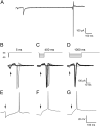Postinhibitory rebound spikes are modulated by the history of membrane hyperpolarization in the SCN
- PMID: 18783377
- PMCID: PMC4126562
- DOI: 10.1111/j.1460-9568.2008.06410.x
Postinhibitory rebound spikes are modulated by the history of membrane hyperpolarization in the SCN
Abstract
The suprachiasmatic nucleus (SCN) of the hypothalamus regulates biological circadian time thereby directly impacting numerous physiological processes. The SCN is composed almost exclusively of gamma-aminobutyric acid (GABA)ergic neurons, many of which synapse with other GABAergic cells in the SCN to exert an inhibitory influence on their postsynaptic targets for most, if not all, phases of the circadian cycle. The overwhelmingly GABAergic nature of the SCN, along with its internal connectivity properties, provide a strong model to examine how inhibitory neurotransmission generates output signals. In the present work we show that hyperpolarizations that range from 5 to 1000 ms elicit rebound spikes in 63% of all SCN neurons tested in voltage-clamp in the SCN of adult rats and hamsters. In current-clamp recordings, hyperpolarizations led to rebound spike formation in all cells; however, low-amplitude or short-duration current injections failed to consistently activate rebound spikes. Increasing the duration of hyperpolarization from 5 to 1000 ms is strongly and positively correlated with enhanced spike probability. Additionally, the magnitude of hyperpolarization exerts a strong influence on both the amplitude of the spike, as revealed by voltage-clamp recordings, and the latency to peak current obtained in either voltage- or current-clamp mode. Our results suggest that SCN neurons may use rebound spikes as one means of producing output signals from a largely interconnected network of GABAergic neurons.
Figures






Similar articles
-
Adenosine modulation of calcium currents and presynaptic inhibition of GABA release in suprachiasmatic and arcuate nucleus neurons.J Neurophysiol. 1997 Jun;77(6):3035-47. doi: 10.1152/jn.1997.77.6.3035. J Neurophysiol. 1997. PMID: 9212255
-
Retrograde suppression of GABAergic currents in a subset of SCN neurons.Eur J Neurosci. 2006 Jun;23(12):3209-16. doi: 10.1111/j.1460-9568.2006.04850.x. Eur J Neurosci. 2006. PMID: 16820011
-
Suprachiasmatic nucleus communicates with anterior thalamic paraventricular nucleus neurons via rapid glutamatergic and gabaergic neurotransmission: state-dependent response patterns observed in vitro.Neuroscience. 2006 Sep 15;141(4):2059-66. doi: 10.1016/j.neuroscience.2006.05.042. Epub 2006 Jun 23. Neuroscience. 2006. PMID: 16797851
-
Electrophysiology of the suprachiasmatic nucleus: synaptic transmission, membrane properties, and neuronal synchronization.J Biol Rhythms. 1993;8 Suppl:S33-7. J Biol Rhythms. 1993. PMID: 8274761 Review.
-
GABAergic mechanisms in the suprachiasmatic nucleus that influence circadian rhythm.J Neurochem. 2021 Apr;157(1):31-41. doi: 10.1111/jnc.15012. Epub 2020 Jul 3. J Neurochem. 2021. PMID: 32198942 Review.
Cited by
-
The transcription factor unc-130/FOXD3/4 contributes to the biphasic calcium response required to optimize avoidance behavior.Sci Rep. 2022 Feb 3;12(1):1907. doi: 10.1038/s41598-022-05942-0. Sci Rep. 2022. PMID: 35115609 Free PMC article.
-
Sensory Experience in Development Balances Excitation and Inhibition to Stabilize Frequency Tuning in Central Auditory Neurons.J Exp Neurosci. 2011 Feb 27;2011(5):9-11. doi: 10.4137/JEN.S6833. J Exp Neurosci. 2011. PMID: 21423853 Free PMC article.
-
OFF-responses of interneurons optimize avoidance behaviors depending on stimulus strength via electrical synapses.PLoS Genet. 2018 Jun 25;14(6):e1007477. doi: 10.1371/journal.pgen.1007477. eCollection 2018 Jun. PLoS Genet. 2018. PMID: 29939997 Free PMC article.
-
Intracellular Chloride Regulation in AVP+ and VIP+ Neurons of the Suprachiasmatic Nucleus.Sci Rep. 2017 Aug 31;7(1):10226. doi: 10.1038/s41598-017-09778-x. Sci Rep. 2017. PMID: 28860458 Free PMC article.
-
Bioresorbable thin-film silicon diodes for the optoelectronic excitation and inhibition of neural activities.Nat Biomed Eng. 2023 Apr;7(4):486-498. doi: 10.1038/s41551-022-00931-0. Epub 2022 Sep 5. Nat Biomed Eng. 2023. PMID: 36065014
References
-
- Aguilar-Roblero R, Verduzco-Carbajal L, Rodríguez C, Mendez-Franco J, Morán J, Perez de la Mora M. Circadian rhythmicity in the GABAergic system in the suprachiasmatic nuclei of the rat. Neuroscience letters. 1993;157:199–202. - PubMed
-
- Akasu T, Shoji S, Hasuo H. Inward rectifier and low-threshold calcium currents contribute to the spontaneous firing mechanism in neurons of the rat suprachiasmatic nucleus. Pflugers Arch. 1993;425:109–116. - PubMed
-
- Albus H, Vansteensel MJ, Michel S, Block GD, Meijer JH. A GABAergic mechanism is necessary for coupling dissociable ventral and dorsal regional oscillators within the circadian clock. Curr Biol. 2005;15:886–893. - PubMed
Publication types
MeSH terms
Substances
Grants and funding
LinkOut - more resources
Full Text Sources

